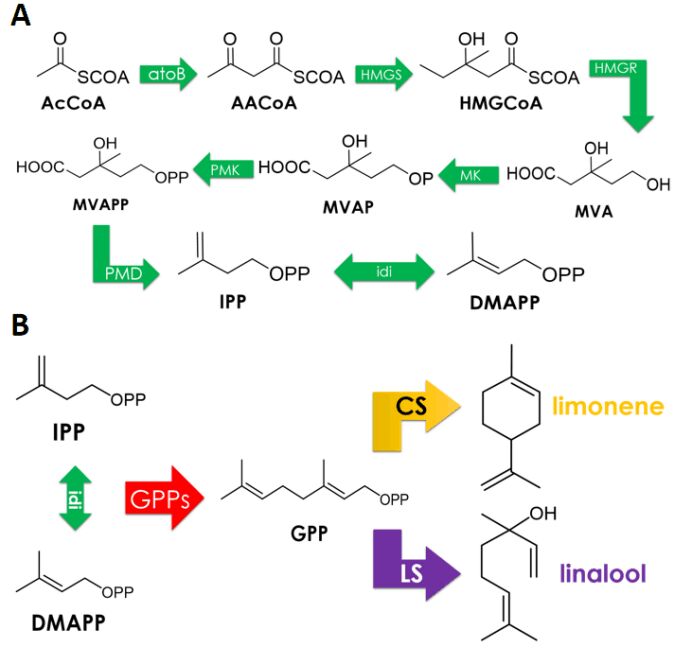Difference between revisions of "Part:BBa K3052010"
(→Background) |
|||
| Line 3: | Line 3: | ||
This circuit contains eight enzymes in plant's MVA pathway to produce geranyl pyrophosphate(GPP),a precursor to various metabolites unique in plants like linalool and limonene. All of the genes in this circuit are inducible by IPTG since all of them are under control of Ptrc or Plac. | This circuit contains eight enzymes in plant's MVA pathway to produce geranyl pyrophosphate(GPP),a precursor to various metabolites unique in plants like linalool and limonene. All of the genes in this circuit are inducible by IPTG since all of them are under control of Ptrc or Plac. | ||
| + | |||
| + | Reference | ||
| + | [1]Alonso-Gutierrez, J., Chan, R., Batth, T. S., Adams, P. D., Keasling, J. D., Petzold, C. J., & Lee, T. S. (2013). | ||
| + | Metabolic engineering of Escherichia coli for limonene and perillyl alcohol production. | ||
| + | Metabolic engineering, 19, 33-41. | ||
<!-- Add more about the biology of this part here | <!-- Add more about the biology of this part here | ||
Revision as of 01:15, 22 October 2019
Precursor Circuit -- a series of enzymes used for GPP production
This circuit contains eight enzymes in plant's MVA pathway to produce geranyl pyrophosphate(GPP),a precursor to various metabolites unique in plants like linalool and limonene. All of the genes in this circuit are inducible by IPTG since all of them are under control of Ptrc or Plac.
Reference [1]Alonso-Gutierrez, J., Chan, R., Batth, T. S., Adams, P. D., Keasling, J. D., Petzold, C. J., & Lee, T. S. (2013). Metabolic engineering of Escherichia coli for limonene and perillyl alcohol production. Metabolic engineering, 19, 33-41.
Sequence and Features
- 10INCOMPATIBLE WITH RFC[10]Illegal EcoRI site found at 1557
Illegal XbaI site found at 8869
Illegal SpeI site found at 10020
Illegal PstI site found at 4253
Illegal PstI site found at 6546
Illegal PstI site found at 6837
Illegal PstI site found at 7196
Illegal PstI site found at 11005 - 12INCOMPATIBLE WITH RFC[12]Illegal EcoRI site found at 1557
Illegal NheI site found at 3467
Illegal SpeI site found at 10020
Illegal PstI site found at 4253
Illegal PstI site found at 6546
Illegal PstI site found at 6837
Illegal PstI site found at 7196
Illegal PstI site found at 11005
Illegal NotI site found at 7688 - 21INCOMPATIBLE WITH RFC[21]Illegal EcoRI site found at 1557
Illegal BglII site found at 1566
Illegal XhoI site found at 11386 - 23INCOMPATIBLE WITH RFC[23]Illegal EcoRI site found at 1557
Illegal XbaI site found at 8869
Illegal SpeI site found at 10020
Illegal PstI site found at 4253
Illegal PstI site found at 6546
Illegal PstI site found at 6837
Illegal PstI site found at 7196
Illegal PstI site found at 11005 - 25INCOMPATIBLE WITH RFC[25]Illegal EcoRI site found at 1557
Illegal XbaI site found at 8869
Illegal SpeI site found at 10020
Illegal PstI site found at 4253
Illegal PstI site found at 6546
Illegal PstI site found at 6837
Illegal PstI site found at 7196
Illegal PstI site found at 11005
Illegal NgoMIV site found at 1443
Illegal NgoMIV site found at 5780
Illegal NgoMIV site found at 7726
Illegal AgeI site found at 8179 - 1000COMPATIBLE WITH RFC[1000]
Validation
Background
In our study, we aim to achieve limonene and linalool synthesis in E.coli DH5α. According to 2018 GreatBay_China team’s experience, no target product was detected using gas chromatography when carrying out shake-flask fermentation with this strain induced by 25uM IPTG for 24 hours due to the lack of endogenous MVA pathways wherein GPP is produced. Thus we decided to co-express an MVA pathway. 2018 GreatBay_China generously gave us one plasmid pJBEI6409(Keasling et al., 2013), which contains a MVA pathway in addition to an GPPs-LS operon. We reconstructed this plasmid and get a plasmid only contains a MVA pathway.
We have used MVA synthesis pathway which is common in plants. Since limonene and linalool have the same synthetic precursor GPP, we have divided the synthesis pathway into two parts:
1. (BBa_K3052001) IPTG inducible precursor circuit which contains eight enzymes of MVA pathway enable conversion from AcCoA to GPP: atoB, HMGS, HMGR, MK, PMK, PMD, idi, trGPPs.
2. (BBa_K3052004, BBa_K3052010) two Production Circuits: limonene synthase or linalool synthase regulated by a ptrc promoter in E. coli.
Reference [1]lonso-Gutierrez, J., Chan, R., Batth, T. S., Adams, P. D., Keasling, J. D., Petzold, C. J., & Lee, T. S. (2013). Metabolic engineering of Escherichia coli for limonene and perillyl alcohol production. Metabolic engineering, 19, 33-41.
Characterization
Precursor Circuit converts carbon sources like glucose to geranyl pyrophosphate(GPP), ready to be catalyzed into limonene and linalool. We constructed the circuit by modification of pJBEI6409. The 11523 bp-length vector is constructed based on pSB1C3 backbone and each operon is under the regulation of Ptrc, and the digestion verification result of two endonucleases is as follows.
Since the product of this circuit, GPP is unstable to be detected via HPLC etc., we performed SDS-PAGE analysis to compare the expression level of key enzyme--GGPs with and without IPTG induction to test if this circuit works properly, and the result is shown below. Click to see our protocol.
The results of SDS-PAG clearly demonstrate the high expression of the GPPs in the precursor circuit, indicating its functionality and eventual GPP synthesis.



